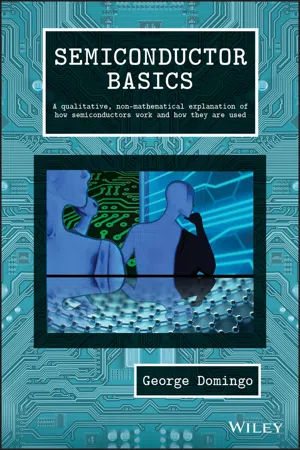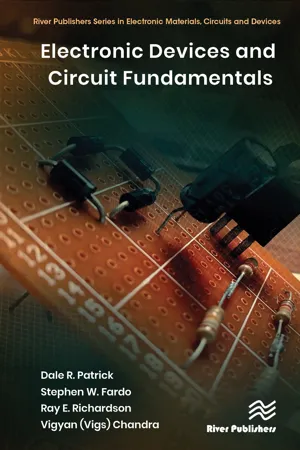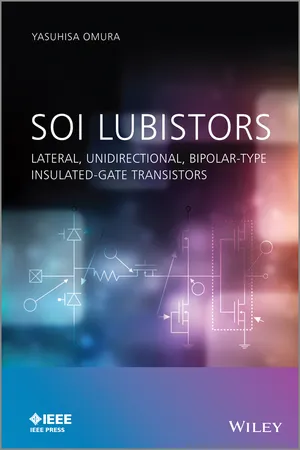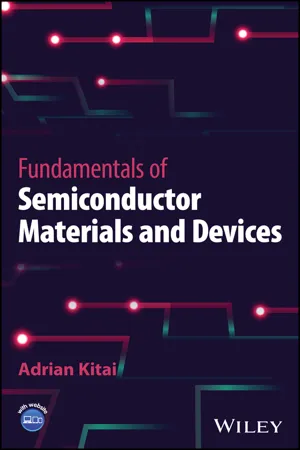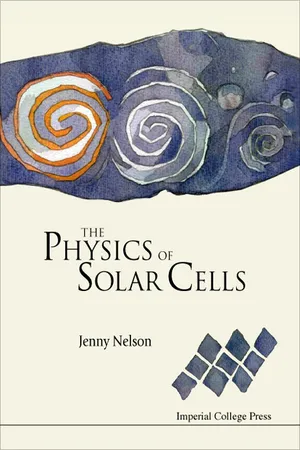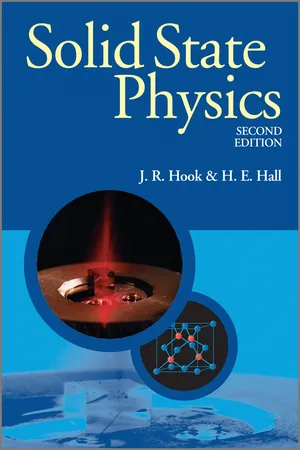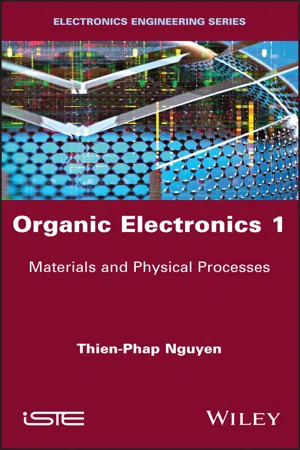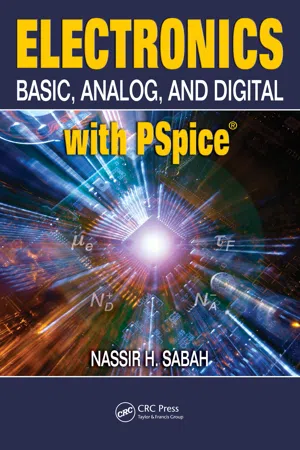Physics
PN Junction
A PN junction is a boundary or interface between a region of semiconductor material doped with positive charge carriers (P-type) and a region doped with negative charge carriers (N-type). This junction forms a diode, allowing current to flow in one direction while blocking it in the opposite direction. It is a fundamental component in electronic devices such as diodes, transistors, and solar cells.
Written by Perlego with AI-assistance
Related key terms
Related key terms
1 of 4
Related key terms
1 of 3
11 Key excerpts on "PN Junction"
- eBook - ePub
Semiconductor Basics
A Qualitative, Non-mathematical Explanation of How Semiconductors Work and How They are Used
- George Domingo(Author)
- 2020(Publication Date)
- Wiley(Publisher)
5 The pn‐JunctionOBJECTIVES OF THIS CHAPTER
After the digression in Chapter 4 , talking about one of the applications that can be understood with only the knowledge of semiconductor materials, its electrical properties and the concept of energy bands and energy gaps, we are now ready to see how by combining two different semiconductor types, one p and the other n, one with extra free holes and the other with extra free electrons at room temperature, we can create very useful devices.In this chapter I explain how a juxtaposition of one p‐ and one n‐type semiconductor creates a pn‐junction or a semiconductor diode, a device that lets the current go in just one direction. The pn‐junction is the fundamental concept that explains all the semiconductor devices we use today.5.1 The pn‐Junction
Consider two boxes, one full of sand and the other empty, the situation I show at the top of Figure 5.1 . What happens when I bring the two boxes together and remove any barrier between them? The sand from the left‐hand box spills over to the empty box, as I show in the lower part of the figure. The sand moves to the right because of a density gradient.Three points are very important:- First, the left‐hand box has lost sand and the right‐hand box has gained some.
- Second, there is a force that limits and prevents more sand from sliding toward the empty box. If instead of sand I had used water, both boxes would reach the same level. This does not happen with sand because of friction, that is, there is a force that prevents the sand moving further to the right.
- eBook - ePub
- Dale R. Patrick, Stephen W. Fardo, Ray E. Richardson, Vigyan (Vigs) Chandra(Authors)
- 2023(Publication Date)
- River Publishers(Publisher)
In the previous chapter, you learned about the construction of P-type and N-type semiconductor materials and how these materials respond when they are coerced into conduction. In this chapter, you will learn about the P–N junction diode. The P–N junction diode is a two-terminal, semiconductor device made of P-type and N-type material. One terminal is attached to the P-type material and the other is attached to the N-type material. The current carriers in a P–N junction diode respond differently than those in pure P-type or N-type semiconductor material. In this section, you will learn how the current carriers respond immediately after the diode is formed.2.1 Describe the physical characteristics of P–N junction diode.In order to achieve objective 2.1, you should be able to:- explain how a P–N junction diode is constructed;
- explain the interaction of current carriers when a P–N junction is formed;
- define the terms junction, diffusion, depletion zone, and barrier potential.
Figure 2.1 shows the crystal structure of a P–N junction diode. The crystal structure is continuous from one end to the other. The point where the N-type and P-type materials in a P–N junction diode are joined is called a junction. The junction serves only as a dividing line that marks the ending of one material and the beginning of the other. This type of structure permits electrons to move readily through the entire structure.Figure 2.2 shows two pieces of semiconductor material before they are formed into a P–N junction. As indicated, each piece of material has majority and minority current carriers. The number of carrier symbols shown in each material indicates the minority or majority function. Note that electrons are the majority carriers in the N-type material and the minority carriers in the P-type material. Holes are the majority carriers in the P-type material and the minority carriers in the N-type material. Both holes and electrons are free to move about in their respective materials.Figure 2.1 - eBook - ePub
SOI Lubistors
Lateral, Unidirectional, Bipolar-type Insulated-gate Transistors
- Yasuhisa Omura(Author)
- 2013(Publication Date)
- Wiley-IEEE Press(Publisher)
Part One Brief Review and Modern Applications of pn-Junction DevicesPassage contains an image 1 Concept of an Ideal PN Junction
As briefly described in the Introduction, Drs J. Bardeen and W. H. Brattain of Bell Laboratory discovered the amplification of signals by the point-contact transistor [1,2]. Within a few years, Dr W. Shockley developed the pn-junction-based bipolar transistor based on the physics of the PN Junction [3].Before the proposal of the bipolar junction transistor by Dr W. Shockley, many scientists had theoretically analyzed the role of electrons and holes in various semiconductors [4–6]; they used quantum mechanics to understand the potential of semiconductor materials. To acquire a comprehensive understanding of transport properties, many assumptions were introduced and the model of Ge-based PN Junction characteristics was proposed. The basic assumptions are as follows:The above assumptions make it possible easily to derive the so-called Shockley current equation [3]:1. All abrupt transitions in the depletion region, p-type, and n-type regions outside the depletion region are assumed to be quasi-neutral.2. Carrier density (electrons and holes) outside the depletion region is described by the electrostatic potential difference between the quasi-neutral n-type and p-type regions.3. A low injection level is assumed. The density of minority carriers injected from the counterpart region is negligibly small so that the local density of majority carriers is altered by the injection.4. No generation and recombination current exists in the depletion region. The electron current and the hole current are constant across the depletion region.5. The built-in potential and applied voltages are supported by a dipole layer with abrupt boundaries, not by the quasi-neutral n-type region or by the quasi p-type region.(1.1)where I S denotes the saturation current as a function of the diffusion constant and the minority carrier lifetime for electrons and holes. This equation is derived assuming that the junction current consists of the diffusion current components in the n-type and p-type regions outside the depletion region. V A denotes the supply voltage applied to the diode terminals. Given the assumption of the recombination process in the depletion region, the theoretical calculation of a forward-biased junction current has to face a couple of difficulties. The usual solution is just simplification because the experimental current–voltage curve is roughly the same as the ideal in Equation (1.1) - Adrian Kitai(Author)
- 2023(Publication Date)
- Wiley(Publisher)
Chapter 8 also make use of p-n junction concepts. A good understanding of all diode-based semiconductor devices requires a fundamental understanding of the p-n junction diode including the electrical contacts made to the diode.We will begin with the abrupt junction semiconductor p-n diode in which the transition from n-type material to p-type material occurs abruptly. This is achieved by a step change in the doping type on either side of the semiconductor junction. In practice, it is possible to make such a transition over a distance of just one or two atomic layers of a semiconductor crystal by the use of semiconductor growth methods in which the concentration of dopants can be rapidly and precisely changed during growth. The abrupt junction diode is the easiest diode to model and understand; however, the concepts can be extended to diodes in which the doping transition is gradual rather than abrupt. Chapter 6 describes a range of semiconductor growth and processing techniques.3.2 DIODE CURRENT
The band model used to describe electron and hole behavior for the p-n junction is shown for equilibrium conditions in Figure 3.2 . Since the n-type and p-type semiconductor regions are in equilibrium, the Fermi energy is constant. Note the difference in position for the valence and conduction band energies on the two sides of the junction. There is a transition region in which the energy bands are sloped to provide a continuous conduction band and a continuous valence band extending from the p-side to the n-side of the junction. The transition region is present even though the p-n junction is abrupt.Band model of p-n junction in equilibrium showing constant Fermi energy and transition region to allow valence band and conduction band to be continuous.FIGURE 3.2We saw in Section 2.15 that band slope is caused by an electric field within a semiconductor. This electric field, referred to as a built-in electric field, exists in the transition region of the p-n junction even without an external applied voltage. The origin of this transition region and the associated electric field will be further described in Section 3.3 . The direction of the field is shown in Figure 3.2 to be consistent with the direction of the band slope (see Section 2.15 ). The built-in field gives rise to both electron and hole drift currents across the junction. The change in electron energy across the p-n junction is labeledprovided equilibrium conditions exist andis referred to as an energy barrier- eBook - ePub
- Jenny Nelson(Author)
- 2003(Publication Date)
- ICP(Publisher)
Chapter 6Analysis of the p–n Junction6.1. IntroductionThe p–n homojunction is the most widely used device structure in photovoltaics. Selective doping of the different sides of a semiconductor wafer p type and n type leads to a potential barrier between the regions. This junction acts as a selective barrier to charge carrier flow, so that there is a low resistance path for electrons to the n contact and for holes to the p contact, thus providing the asymmetry in resistance which is necessary for photovoltaic conversion. By control of the doping levels, large potential barriers can be established which make it possible to generate large photovoltages. It has the practical advantage that the junction can be prepared from a single crystal semiconductor wafer without the need for a metallurgical interface, and the associated problems of interface states.The photovoltaic function of a p–n junction can be analysed using the theoretical apparatus introduced in Chapter 3 and 4 . In general, the problem consists of solving a set of coupled differential equations for the electron density, hole density and the electrostatic potential, given specified forms for the photogeneration, the recombination and the electron and hole currents. It is in general a complex problem but, with the benefit of two approximations, analytic solutions for the J(V) characteristic under different conditions can be found. These two approximations are the depletion approximation, and the approximation that recombination in the doped material is linear. This allows the differential equations to be uncoupled and linearised. In the next sections we first outline the approach to solving the p–n junction, before presenting the solutions and discussing some of the implications for junction design.6.2. The p–n Junction6.2.1. Formation of p–n junctionAs explained in Chapter 5 , a p–n junction is established when a layer of p-type semiconductor and a layer of n-type material are brought together. Carriers diffuse across the junction leaving behind a layer of fixed charge, due to the now ionised impurity atoms, on either side. This space charge sets up an electrostatic field which opposes further diffusion across the junction. Equilibrium is established when diffusion of majority carriers across the junction is balanced by the drift of minority carriers back across the junction in the built in electrostatic field. At this point the Fermi levels of the p and n - eBook - ePub
- J. R. Hook, H. E. Hall(Authors)
- 2013(Publication Date)
- Wiley(Publisher)
CHAPTER 6
Semiconductor devices
I find television very educating. Every time somebody turns on the set I go into the other room and read a book.—Groucho Marx6.1 INTRODUCTION
The use of semiconductors in electronics is probably the biggest contribution of solid state physics to twentieth century technology. To understand the great majority of semiconductor devices it is necessary to consider the behaviour of charge carriers near a surface or interface. Of particular importance are the boundary between an n-type region and a p-type region, the boundary between a semiconductor and an insulator, and the boundary between two different semiconductors. In this chapter we consider devices using these three possibilities. Our emphasis will be on understanding the physics of the devices, not the technical applications.6.2 THE p–n JUNCTION WITH ZERO APPLIED BIAS
A boundary between p and n regions can be produced in a number of ways. The deposition of a thin layer of donor impurities on the surface of a p-type semiconductor, followed by a controlled period of time at a high temperature to allow diffusion of the donors into the substrate, creates an n-type region near the surface where the donors outnumber the original acceptors. A p–n junction can also be produced by epitaxial growth (section 6.6) on a p-type substrate of material containing donor impurities. Both of the above methods can of course alternatively create an acceptor-rich region in contact with an n-type substrate. Other methods also exist for producing a region of semiconductor in which a changeover from p-type to n-type behaviour occurs on a short length scale.The useful behaviour of a p–n junction results from the effect on the electron energy levels in the region of the junction as shown in Fig. 6.1 . The energy levels are shown as a function of position only, and no distinction is made between different k values; electrons in the conduction band are indicated schematically by full circles and holes in the valence band by open circles. The factor controlling the relative positions of the levels on the two sides of the junction is the necessity for a uniform chemical potential; this is the condition for thermal equilibrium between two or more systems when particles can move freely between them (see Mandl,2 chapter 8). In the case of a p–n junction the equilibrium is achieved by a small transfer of electrons from the n region to the p region, where they annihilate with holes, leaving a region with very few free carriers† near the junction, known therefore as the depletion layer (Fig. 6.2(b )). The positively charged ionized donors in the n region of the depletion layer and the negatively charged ionized acceptors in the p region leave the n region positively charged and the p region negatively charged (Fig. 6.2(c )). This results in the lowering of electron energy levels on the n side and the raising on the p side, shown in Fig. 6.1 , which causes the chemical potential to be position-independent as required; remember that Fig. 6.1 is a diagram of electron - eBook - ePub
- Geoff Lewis(Author)
- 2013(Publication Date)
- Routledge(Publisher)
piecewise linear device, with a relatively low forward resistance and very high or even infinite reverse resistance. However, the total voltage/current characteristic is more precisely described by the following equations, as logarithmic:Figure 32.1 PN Junction.
These equations hold true for any PN Junction and have been shown to be accurate to within 1 % over more than eight decades of current.where I = forward current, Io = reverse saturation current q = electron charge (1.602 x 10-19 coulombs) k = Boltzmann’s constant (1.38 x 10-23 J/K) V = voltage across junction T = absolute temperature n = constant typically close to unity. 32.1.1 Bi-polar transistors
Figure 32.2 shows the cross-section through one type of transistor. The surface of a piece of N type silicon which forms the substrate is coated with a thin insulating layer of silicon dioxide(SiO2 ). This operation is often performed by an evaporation process at a temperature of 300 to 400°C, and at low pressure in the presence of either silicon or silicon monoxide and oxygen.Figure 32.2 Planar bi-polar transistor.A small area of the SiO2 is then etched away using a photographic and masking technique to leave a window in which the P type base region will be formed. When this area is exposed to an atmosphere of a P type gas such as boron, the exposed region will be converted into P type semiconductor. The surface is again exposed to the SiO2 process so that the insulating layer is reformed. A smaller window is then etched into this layer and the area exposed to an N type impurity atmosphere such as phosphorus. This converts the exposed region back into N type semiconductor. A further insulating and etching operation leaves small windows for the metallisation of the electrode connection areas. Because the transistor is built up layer by layer, the process is referred to as planar - eBook - ePub
Organic Electronics 1
Materials and Physical Processes
- Thien-Phap Nguyen(Author)
- 2021(Publication Date)
- Wiley-ISTE(Publisher)
1 Semiconductor TheoryThis chapter provides a brief overview of the basic concepts of semiconductor theory with regard to particular physical characteristics that allowed the creation of electronic components that would revolutionize various technologies starting in the middle of the 20th Century. We will now describe the operation of P–N junctions, which are the essential components for the creation of electronic devices. This basic knowledge will then allow us to address physical processes in organic materials and then to understand the operation and use of devices based on new organic semiconductors.1.1. Introduction
In electronics, the basic materials are semiconductors (SCs). They differ from metals in their dependence on the temperature of their electric characteristics. Essentially, when the temperature increases, the resistivity of metals increases, while the resistivity of SCs decreases. The theoretical contributions made by quantum mechanics allowed the electrical properties of SCs to be studied and explained based on the theory of energy bands. Unlike metals, in which the charge carriers are electrons, SCs can also carry positive charges, known as holes, that contribute to the electrical conductivity of these materials. The concentration of the carriers can also be changed by “doping”, that is, the incorporation of the selected impurities in a determined quantity. This process not only allows the conductivity of the SC to be changed, but also favors the transport of one type of charge carrier at the expense of the other. An SC is characterized as N-type if the majority of the carriers are electrons and as P-type if the majority of the carriers are holes.The combination of an N-type and P-type SC is a P–N junction, which is the fundamental element of all traditional electronic components. The assembly of these elements, prepared with other materials, makes it possible to create components that perform special functions, and the design of the circuits with these components leads to multiple applications of various different types. - eBook - ePub
- Pradeep Fulay, Jung-Kun Lee(Authors)
- 2016(Publication Date)
- CRC Press(Publisher)
Forward bias: A voltage applied to a p-n junction in which the positive terminal of an external voltage supply is connected to the p-side of the p-n junction. This bias can overcome the built-in electric field and cause the p-n junction to conduct.Forward current (I F ):The current in a p-n junction under a forward bias.Generation current (I 0 ):The total current due to the drift of thermally generated carriers under the influence of an electric field in the depletion region. These go from the n-side to the p-side.Hole diffusion length (L p ):The average distance a hole can diffuse before recombining with an electron.Ideal diode equation: The equation that describes the I–V characteristics of an ideal p-n junction (Equation 5.63 ):I =I 0[ exp(− 1 ])q Vk BImpact ionization: A process in which a high-energy electron collides with other electrons, breaking bonds in a material and causing one of the valence electrons to move into the conduction band, which creates a hole. This process eventually leads to an avalanche breakdown in a p-n junction.Internal electric field: The electric field developed by positively charged donor ions, which are left behind as the electrons diffuse from the n-side to the p-side, and negatively charged acceptor ions, which are left behind as the holes diffuse from the p-side to the n-side.Knee voltage: The voltage on the I–V curve for a diode, at which the forward current begins to increase exponentially. This value is very close to the built-in potential (V 0 ) for the p-n junction.One-sided p-n junction: A p-n junction in which one side is very heavily doped. This side is indicated with a + superscript (e.g., a p+ -n junction is where the p-side is very heavily doped).Poisson’s equation: An equation relating the gradient of an electric field to the charge density and the dielectric permittivity of the material (ε), given by Equation 5.30 :Reverse bias:=d 2ϕ ( x )dx 2=ρ ( x )εd E ( x )d x - eBook - ePub
Electronics
Basic, Analog, and Digital with PSpice
- Nassir H. Sabah(Author)
- 2017(Publication Date)
- CRC Press(Publisher)
Typical parameters are V p ≅ 0.15 V, V v ≅ 0.5 V, V F ≅ 1 V, I p ≅ 2 mA, and I v ≅ 0.1 mA. Tunneling takes place at virtually the speed of light, with very little capacitance associated with the junction. Tunnel diodes are therefore suitable for high-frequency operation, as switches and as negative resistance oscillators (Example SE3.4). The peak point (I p, V p), which depends only on tunneling, is quite insensitive to temperature. On the other hand, the valley point (I v, V v) depends on the normal forward characteristic of a PN Junction diode and is temperature sensitive. FIGURE 3.5.3 i–v characteristic of tunnel diode. 3.6 Contacts between Dissimilar Materials Contacts between dissimilar materials are ubiquitous. The PN Junction is between two dissimilar semiconductors that are in turn connected to external elements by semiconductor–metal contacts. A different metal is almost invariably used to connect these metal contacts to the diode terminals, which introduces yet another type of contact between dissimilar materials, this time a metal–metal contact. When dissimilar materials are in contact, some general principles apply. Concepts : Under equilibrium conditions, the Fermi level E F, being the equilibrium electrochemical potential of current carriers, must be the same throughout. The alignment of E F is brought about by a contact potential, which is the junction potential in the case of the PN Junction. The contact potential lowers electron energy levels on the positively charged side, with respect to those on the negatively charged side, so as to align E F. The contact potential is associated with a net charge on either side of the contact. In semiconductors, the net charge is a space charge in a depletion region of the semiconductor - eBook - ePub
- Emiliano R. Martins(Author)
- 2022(Publication Date)
- Wiley(Publisher)
ext. Thus, for negative bias, the current is nearly equal to the saturation current:The saturation current, however, is typically very small. In silicon diodes, for example, the saturation current is of the order of 10−9 A. That means that a p‐n junction is a very poor conductor when reverse biased, as we had already concluded in the previous section. For forward bias, on the other hand, the current increases exponentially with the voltage, which means that the p‐n junction is an excellent conductor when forward biased. These features are nicely captured by an IxV plot of Shockley equation (Equation (3.68) , Equation (3.69) ), as shown in the blue line of Figure 3.10 , which assumes I0 = 10−9 A. The parameter ς, which I sneaked into the plot, is known as the ideality factor. This parameter captures some effects that we did not take into account in our derivation, mainly recombination in the depletion region. It takes on values between one and two, and it enters Shockley equation as:(3.69)Current x Voltage plot of Shockley equation assuming I0 = 10−9 A and for two conditions of ideality factor ς.Figure 3.10I added a plot of a second curve for a higher value of ς, just for you to get a feel of what it does, but a full treatment of the ideality factor is beyond the scope of this book (see section 3.6 for suggestions on more advanced books).If you take a course in electronic circuits, one of the first things you will learn is how to analyse circuits involving diodes. Compared to the analysis of circuits involving only resistors, capacitors and inductors, the presence of diodes complicates the analysis because Shockley equation is non‐linear. But, as a first approximation, one can treat the diode as an open circuit if it is operating in reverse bias, and as short‐circuit if it is operating in forward bias. The reason why treating it as a short‐circuit in forward bias is a good approximation can be understood by inspection of Figure 3.10 : it takes a huge change in current to obtain a small change in voltage. Thus, in practice, the voltage is always about the same, not mattering the actual current that is flowing. If the voltage is small compared to the source, then you can just ignore it (thus, a short‐circuit). If it is not, you may have to consider a constant voltage drop, but that is still much simpler than considering the full Shockley equation. In the examples of Figure 3.10 , the operation voltages are about 0.5 V for the ideal diode (ς = 1) and about 0.7 V for the non‐ideal diode (ς
Index pages curate the most relevant extracts from our library of academic textbooks. They’ve been created using an in-house natural language model (NLM), each adding context and meaning to key research topics.
Explore more topic indexes
Explore more topic indexes
1 of 6
Explore more topic indexes
1 of 4
